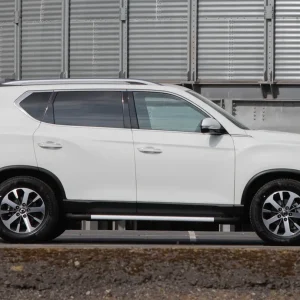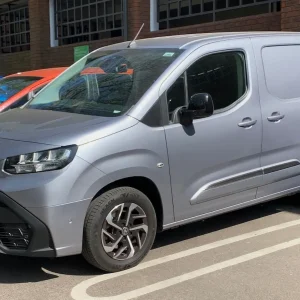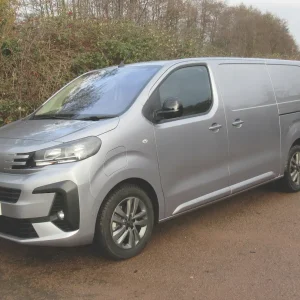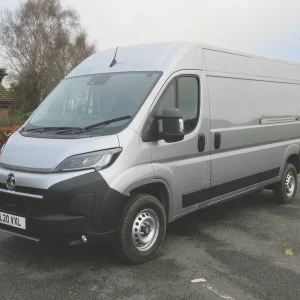How do you like your vans? If you favour a bit dull looking but solidly built, the sort that will seldom if ever let you down and hold their value when you come to sell them second-hand, then go and visit your local Volkswagen Commercial Vehicles dealership.
Most of the range falls into that category, and the Caddy is a prime example.
We first road-tested the current Caddy when it came out almost four years ago. Since then it has been through engine changes, with Euro5 fully replaced by Euro6. A petrol power plant has been added as diesel has been demonised, and an electric Caddy is in the pipeline. Spec levels have been changed too, including the recent addition of an optional Business Pack for the entry-level Startline derivative.
VW’s competitors have not been slow to introduce new models since 2015. New arrivals include the latest Citroen Berlingo, Peugeot Partner, Vauxhall Combo and Toyota Proace City, all of which share the same basic design.
Caddy buyers can pick from a 102hp 1.0-litre TSI petrol engine or a 2.0-litre TDI diesel at 102hp or 150hp. The transmission alternatives are a five-speed manual or the hugely admirable auto dual-clutch six-speed Direct Shift Gearbox – the gearbox you really want.
Load volume is either 3.2m3 or 4.2m3 with the latter carrying the Caddy Maxi moniker.
Gross payload capacity ranges from 545kg to 736kg, and the Caddy Maxi is additionally marketed with a second row of seats and a cargo bay at the back.
In addition to Startline, the Caddy is offered with Trendline and Highline trim levels. We sampled a 102hp short-wheelbase Caddy in Highline trim and Sandstorm Yellow metallic paint.
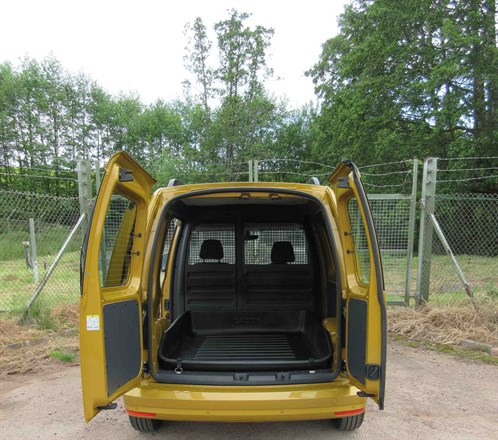
Load bay
Access to the 3.2m3 cargo bay is by means of twin asymmetric rear doors with the narrower of the two on the offside, or through a sliding nearside door.
The back doors are glazed, which may give rise to security concerns, and equipped with a wash/wipe system.
A half-height plastic bulkhead topped off by a plastic grille divides the cab from the cargo area.
The quality of VW engineering means that the combination is doubtless strong enough to stop a shifting load, but we would still prefer an all-steel barrier, even though its extra weight would result in a slightly lower payload capacity.
Build quality is up to Volkswagen’s usual exemplary standard. Unfortunately, however, our demonstrator’s cargo area was not lined, aside from some half-height panels on the doors and a panel on the offside at wheel-box height. There was no protection for the floor, but a removable plastic load tray was installed, secured by straps to the rearmost of six floor-mounted tie-down points.
Extra carrying capability was provided by optional roof-mounted rails finished in black.
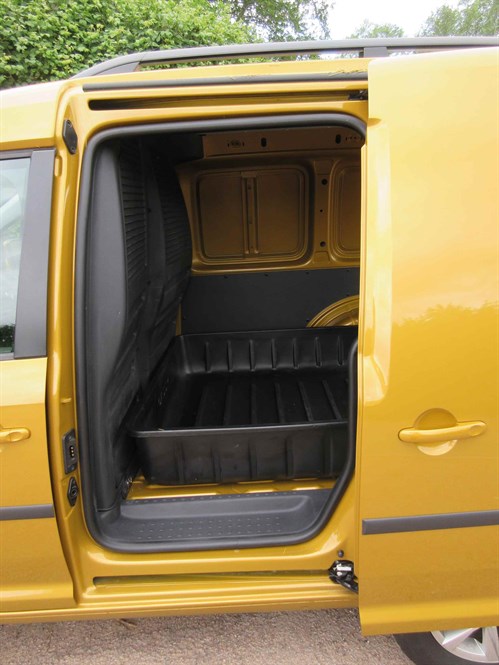
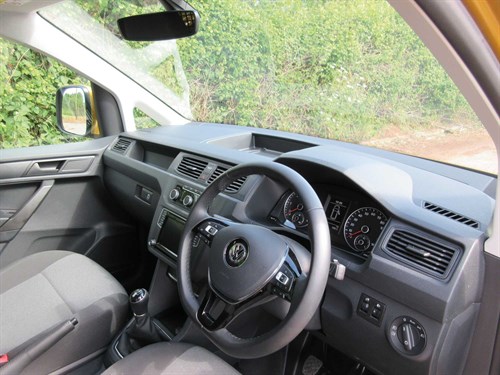
Interior and equipment
Stowage facilities include bins in each door, a lidded and lockable glove box with a tray just above it, another tray on top of the dash, and a full-width shelf above the heated windscreen.
A cubbyhole at the bottom of the dashboard plays host to a 12V power point plus USB and aux-in sockets. No less than four cupholders are positioned between the seats, which seems a little over the top for a two-seater cab.
Climate control complete with a cooled glove compartment is fitted along with satnav and a full-colour touchscreen. Guide & Inform can tell you everything from where the nearest fuel stations are to the weather at your destination.
Remote controls for the DAB digital radio are located on the height-adjustable leather-trimmed steering wheel. The driver’s seat is height-adjustable too as is – unusually – the passenger seat. There are hidden compartments beneath both.
Reversing sensors helped protect our VW from accidental damage. While the heated windows in the rear doors offer vision rearwards, the grille on top of the bulkhead means it is partially obscured.
Electric windows and mirrors are installed. The latter are heated, and have a separate wide-angle section, and the mirror casings, door handles and front and rear bumpers are all finished in the same metallic paint as the body.
Both occupants of the cab are protected by front and side airbags.
The headlights come on automatically when driving conditions warrant it. So do the wipers if it is raining.
Onboard safety devices include hill-start assist plus ABS, electronic stability programme, electronic brakeforce distribution, brake assist, traction control system, engine drag torque control and an electronic diff lock. Front assist with city emergency braking are both included too. The former alerts the driver if they get too near to the vehicle in front, gives a quick jolt to the brakes if the alert is ignored, then immediately applies them in full if and when the driver presses the brake pedal. The latter automatically applies the brakes at speeds below 30km/h (19mph) if the driver fails to spot an obstruction.
Another praiseworthy standard feature is post-collision braking. It automatically applies the brakes after a collision if the driver is incapacitated, the aim being to mitigate the risk of severe secondary impacts.
Our test van was equipped with optional adaptive cruise control, including a speed limiter. It automatically ensures that you maintain a safe distance from the vehicle in front of you.
Turning to the suspension, McPherson struts are installed at the front while a rigid axle on leaf springs with load-sensitive shock absorbers helps to support the rear. Our Caddy rode on 15in alloys shod with 195/65 R15 Continental ContiEcoContact tyres.
Power-assisted steering delivers a 11.1m turning circle kerb to kerb.
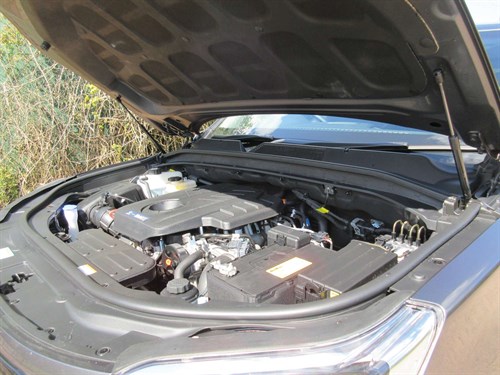
Engine and gearbox
The Caddy’s transverse-mounted four-cylinder in-line common-rail direct-injection diesel is equipped with a variable-geometry turbocharger and an intercooler. Max power makes its presence felt across a 2,900-4,000rpm plateau while top torque of 250Nm impacts across a 1,300-2,800rpm plateau.
Selective Catalytic Reduction technology is used to achieve Euro6, which means the diesel Caddy has to be dosed with AdBlue held in a nine-litre onboard tank. A particulate filter is a standard feature.
Our demonstrator came with the manual gearbox.
Driving
The Caddy handles remarkably well. Push it hard through bends and it clings doggedly to the tarmac, and should only come unstuck if you do something silly.
The ride is firm, but not unpleasantly so, and a slick, quick gear change helps you make rapid progress.
With plenty of mid-range get-up-and-go, the engine offers ample horses for a van of this size. Furthermore, it is frugal, despite the fact that in our case it was married to a five- rather than a six-speed transmission. Stop/start, which can be switched off, clearly helps to reduce fuel consumption, and is combined with regenerative braking, which recoups energy that would otherwise be lost.
We averaged around 55mpg – below the official figure, but not by a huge amount – lightly laden over a mixture of motorway, A- and B-roads and urban routes.
Our Caddy was a tad on the noisy side, with lots of wind noise and road roar from the rear accompanied by the sound of diesel sloshing around in the fuel tank. Having a bulkhead topped off by a mesh grille rather than one that was completely solid to its full height probably made noise levels slightly worse than they would otherwise be.
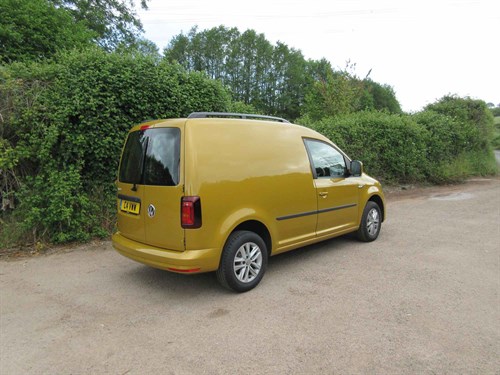
Operating
Customers can choose from either fixed service intervals (one-year/10,000-mile interim, two-year/20,000-mile full) or variable ones instead.
In the latter case the van tells you when it needs to visit the workshop. Lights illuminate accordingly, and typically do so at the two-year/18,000-mile mark if they haven’t done already.
The Caddy is covered by a three-year/100,000-mile warranty, and a UK and European roadside assistance package is in force over the same period.
So is the paintwork warranty. The anti-perforation corrosion warranty lasts for 12 years.
C20 SWB Highline 2.0 TDI 102hp 5-speed manual
Price (ex VAT) £19,670
Price range (ex VAT) £16,545-£25,070
Gross payload 645kg
Load volume 3.2m3
Load length 1,779mm
Load width (min/max) 1,170/1,556mm
Load bay height 1,244mm
Loading height 577mm
Rear door aperture 1,183×1,134mm
Side door aperture 701×1,097mm
Gross vehicle weight 2,141kg
Braked trailer towing weight 1,500kg
Residual value 24.1 %*
Cost per mile 38.7p
Engine size/power 1,968cc, 102hp @ 2,900-4,000rpm
Torque 250Nm @ 1,300-2,800rpm
Gearbox 5-spd
Fuel economy 60.1mpg
Fuel tank 60 litres
CO2 124g/km
Warranty 3yrs/100,000mls
Service intervals 2yrs/18,000mls
Insurance group 30E
Price as tested £21,250
* after 4yrs/80,000mls; Source: KwikCarcost
Options fitted
Black roof rails £190
Adaptive Cruise Control inc. speed limiter £285
Metallic paint £430
Bi-xenon headlights £675
Rivals
Ford Transit Connect
Price (ex VAT) £15,665-£21,805
Load volume 2.9-3.6m3
Gross payload 579-865kg
Engines 100hp 1.0 petrol, 75hp, 100hp, 120hp 1.5 diesel
Verdict: With one of the slickest gear-changes we have ever come across, the Transit Connect garners top marks in virtually all departments. Its on-the-road performance is first class, its fuel consumption won’t make too big a dent in your bank balance, and the cab interior offers a comfortable working environment with lots of storage space. Its diesel is the same 1.5-litre used in Partner/Berlingo/Combo/Proace City.
Renault Kangoo/Kangoo Maxi
Price (ex VAT) £15,830-£27,600
Load volume 3.0-4.0m3
Gross payload 650-800kg
Engines 75hp, 90hp, 110hp 1.5 diesel, 44kW electric
Verdict: Opt for the diesel and you will end up sitting behind an impressively frugal power plant coupled with a user-friendly gearbox. Much of the current interest in the Kangoo centres around the zero-emission electric model, however, and there is no denying that it is a practical, working tool that will meet the needs of a wide cross-section of customers. Day-to-day running costs are modest.
Renault Kangoo/Kangoo Maxi
Price (ex VAT) £15,830-£27,600
Load volume 3.0-4.0m3
Gross payload 650-800kg
Engines 75hp, 90hp, 110hp 1.5 diesel, 44kW electric
Verdict: Opt for the diesel and you will end up sitting behind an impressively frugal power plant coupled with a user-friendly gearbox. Much of the current interest in the Kangoo centres around the zero-emission electric model, however, and there is no denying that it is a practical, working tool that will meet the needs of a wide cross-section of customers. Day-to-day running costs are modest.
The Final Verdict
|
Design |
7/10 |
Well thought out but the styling’s unlikely to make pulses race. |
|
Cabin |
8/10 |
Lots of storage space and a comfortable working environment. |
|
Ride |
7/10 |
Firm, but not unpleasant, and its tautness benefits handling. |
|
Refinement |
6/10 |
High build quality meant no creaks, but in-cab noise was excessive. |
|
Load area |
7/10 |
Access is easy, but our cargo bay lacked protection. |
|
Handling/performance |
8/10 |
Clung on through bends and engine had lots of mid-range poke. |
|
Engine/transmission |
7/10 |
Well-matched, with the latter offering a smooth, efficient change. |
|
Standard equipment |
8/10 |
Almost all the goodies are present and correct. |
|
Operating costs |
8/10 |
Comprehensive warranty, sensible servicing, respectable mpg. |
|
What Van? subjective rating |
7/10 |
A durable and safe package that looks unlikely to let you down. |

